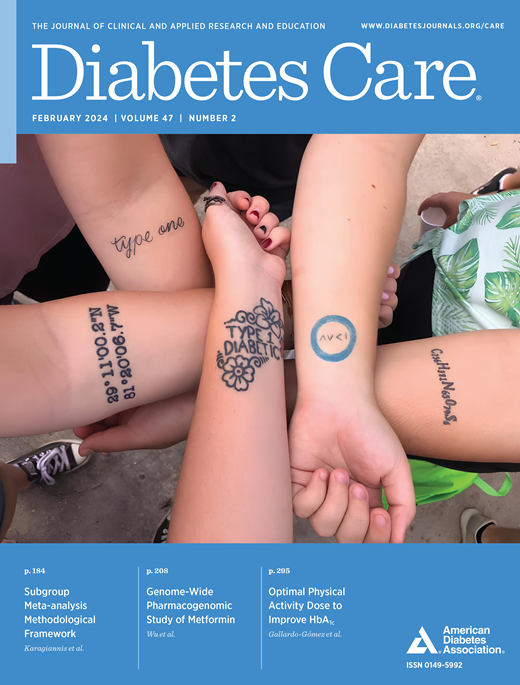连续葡萄糖监测和间歇扫描连续葡萄糖监测对 2 型糖尿病患者的疗效和安全性:介入性证据的系统回顾和元分析
IF 16.6
1区 医学
Q1 ENDOCRINOLOGY & METABOLISM
引用次数: 0
摘要
背景 传统的糖尿病自我血糖监测(SMBG)涉及到不方便的手指穿刺。连续血糖监测(CGM)和间歇性扫描 CGM(isCGM)系统提供 CGM,通过方便、全面的数据加强 2 型糖尿病(T2D)管理。目的 评估 CGM 和 isCGM 与常规护理或 SMBG 相比对 T2D 患者的益处和潜在危害。数据来源 我们对截至 2023 年 8 月的 MEDLINE、Embase、Cochrane 图书馆、Web of Science 和参考文献进行了全面检索。研究筛选 我们分析了符合以下标准的研究:随机对照试验(RCT),对 T2D 患者进行了至少为期≥8 周的两种干预措施比较,包括实时/回顾性 CGM、短期/长期 CGM、isCGM 和 SMBG,并报告了血糖和相关数据。数据提取 我们使用标准化的数据收集表,提取包括作者、年份、研究设计、基线特征、干预措施和结果在内的详细信息。数据合成 我们纳入了 26 项 RCT(17 项 CGM 和 9 项 isCGM),涉及 2,783 名 T2D 患者(CGM 632 人 vs. 常规护理/SMBG 514 人,isCGM 871 人 vs. 常规护理/SMBG 766 人)。CGM 降低了 HbA1c(平均差异-0.19% [95% CI -0.34,-0.04])和血糖药物治疗效果评分(-0.67 [-1.20 至-0.13]),降低了用户满意度(-0.54 [-0.98,-0.11]),增加了不良事件风险(相对风险 [RR] 1.isCGM 可使 HbA1c 降低 -0.31% (-0.46, -0.17),提高用户满意度 (0.44 [0.29, 0.59]),改善 CGM 指标,并增加不良事件风险 (RR 1.30 [0.05, 1.62])。CGM 和 isCGM 对身体成分、血压或血脂水平均无明显影响。局限性 局限性包括样本小、单项研究结果、人群差异以及年轻成年人的不确定性。此外,针对大多数终点的研究只有 10 项,这限制了综合分析的进行,而且随着时间的推移,技术的进步也需要加以考虑。结论 CGM 和 isCGM 都能降低 T2D 患者的 HbA1c 水平,与 CGM 不同的是,isCGM 的使用与用户满意度的提高有关。这些设备对身体成分、血压和血脂水平的影响尚不清楚,而 CGM 和 isCGM 的使用与不良事件风险的增加有关。本文章由计算机程序翻译,如有差异,请以英文原文为准。
Efficacy and Safety of Continuous Glucose Monitoring and Intermittently Scanned Continuous Glucose Monitoring in Patients With Type 2 Diabetes: A Systematic Review and Meta-analysis of Interventional Evidence
BACKGROUND Traditional diabetes self-monitoring of blood glucose (SMBG) involves inconvenient finger pricks. Continuous glucose monitoring (CGM) and intermittently scanned CGM (isCGM) systems offer CGM, enhancing type 2 diabetes (T2D) management with convenient, comprehensive data. PURPOSE To assess the benefits and potential harms of CGM and isCGM compared with usual care or SMBG in individuals with T2D. DATA SOURCES We conducted a comprehensive search of MEDLINE, Embase, the Cochrane Library, Web of Science, and bibliographies up to August 2023. STUDY SELECTION We analyzed studies meeting these criteria: randomized controlled trials (RCT) with comparison of at least two interventions for ≥8 weeks in T2D patients, including CGM in real-time/retrospective mode, short-/long-term CGM, isCGM, and SMBG, reporting glycemic and relevant data. DATA EXTRACTION We used a standardized data collection form, extracting details including author, year, study design, baseline characteristics, intervention, and outcomes. DATA SYNTHESIS We included 26 RCTs (17 CGM and 9 isCGM) involving 2,783 patients with T2D (CGM 632 vs. usual care/SMBG 514 and isCGM 871 vs. usual care/SMBG 766). CGM reduced HbA1c (mean difference −0.19% [95% CI −0.34, −0.04]) and glycemic medication effect score (−0.67 [−1.20 to −0.13]), reduced user satisfaction (−0.54 [−0.98, −0.11]), and increased the risk of adverse events (relative risk [RR] 1.22 [95% CI 1.01, 1.47]). isCGM reduced HbA1c by −0.31% (−0.46, −0.17), increased user satisfaction (0.44 [0.29, 0.59]), improved CGM metrics, and increased the risk of adverse events (RR 1.30 [0.05, 1.62]). Neither CGM nor isCGM had a significant impact on body composition, blood pressure, or lipid levels. LIMITATIONS Limitations include small samples, single-study outcomes, population variations, and uncertainty for younger adults. Additionally, inclusion of <10 studies for most end points restricted comprehensive analysis, and technological advancements over time need to be considered. CONCLUSIONS Both CGM and isCGM demonstrated a reduction in HbA1c levels in individuals with T2D, and unlike CGM, isCGM use was associated with improved user satisfaction. The impact of these devices on body composition, blood pressure, and lipid levels remains unclear, while both CGM and isCGM use were associated with increased risk of adverse events.
求助全文
通过发布文献求助,成功后即可免费获取论文全文。
去求助
来源期刊

Diabetes Care
医学-内分泌学与代谢
CiteScore
27.80
自引率
4.90%
发文量
449
审稿时长
1 months
期刊介绍:
The journal's overarching mission can be captured by the simple word "Care," reflecting its commitment to enhancing patient well-being. Diabetes Care aims to support better patient care by addressing the comprehensive needs of healthcare professionals dedicated to managing diabetes.
Diabetes Care serves as a valuable resource for healthcare practitioners, aiming to advance knowledge, foster research, and improve diabetes management. The journal publishes original research across various categories, including Clinical Care, Education, Nutrition, Psychosocial Research, Epidemiology, Health Services Research, Emerging Treatments and Technologies, Pathophysiology, Complications, and Cardiovascular and Metabolic Risk. Additionally, Diabetes Care features ADA statements, consensus reports, review articles, letters to the editor, and health/medical news, appealing to a diverse audience of physicians, researchers, psychologists, educators, and other healthcare professionals.
 求助内容:
求助内容: 应助结果提醒方式:
应助结果提醒方式:


